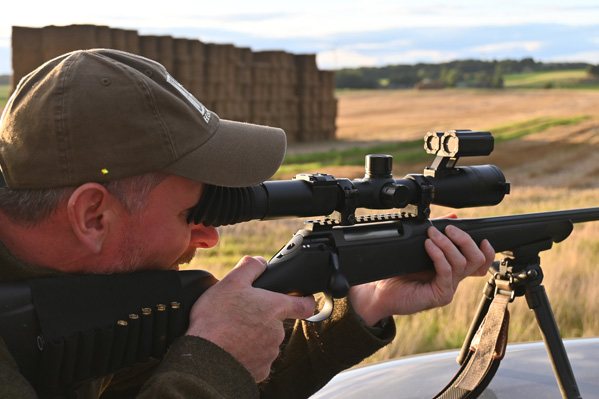Hornady 35-grain Superformance Varmint NTX ammunition in .223
- By Chris Parkin
-
0
 Comments
Comments
- Last updated: 09/01/2024

I use non-toxic ammunition for review purposes, where possible, to learn a rifle’s adaptability. The other reason is that a local falconer benefits from what I shoot, so lead ammunition is forbidden.
Hornady’s offering
Most .223 factory rifles use a 1:12” twist rate, so Hornady has made sure the bullets will stabilise by reducing their physical mass to 35-grains. The common lead-cored weights are 50 and 55-grains. The bullets follow the familiar V-Max look, but the polymer tips are a slightly deeper, pink colour, which helps to differentiate them. The bullet itself is 18.1mm long, compared to the 20.7mm of a 55-grain V-Max. Inside the case is a consistent 28.1-grams of a mixed ball powder, which I presume to be a double-based nitrocellulose/nitroglycerine mix. The bullet shows a secant ogive with a small boat tail at the rear. This is notably different to the flat-based 55-grain V-Max and hopes to deliver desirable external and terminal ballistics.
Testing
I shot the ammunition from a reliable Sauer 100 rifle with a slightly faster 1:10” twist rate. This rifle handled the previous 55-grain GMX rounds (which needed 1:10” minimum) with ease due to the fast twist, but Hornady appreciates that 1:10” is the exception, not the norm. When engineering the NTX, the optional light, short, and fast bullet design was assured to work in most rifles, especially when lower-density copper dominates the construction.
The performance on target was reliable, with 5-round groups averaging ¾ MOA over a box of 20 rounds. The point of impact averaged 10mm different at 100m from my previous V-Max zero, which is useful to know if I ever need to swap back and forth. Importantly, unlike some copper bullets, the NTX didn’t seem to need much bedding into the barrel with fouling shots, and conversely, they haven’t caused any cleaning problems.
The muzzle velocity is advertised at 4000 fps (likely from a 26” test barrel), and the 20” Sauer delivered a productive 3660 fps | 1041 ft-lbs. The FX chronograph also generated a G1 Ballistic Coefficient (BC) of 0.206 and displayed a 42 fps extreme spread across a 7-round group.
Conclusion
I have been using the ammunition regularly and accuracy is reliable, and the terminal ballistics seem to favour pass-throughs with controlled expansion. Rabbits appear to be humanely dealt with on the spot, with no observed ‘detonation’, which is usually experienced with varmint bullets at similar speeds. Hares presented more resistance if chest shots were needed (impractical headshot scenario), and they showed a more noticeable exit wound, thankfully without excessive meat damage. Foxes showed a more explosive exit wound, especially when any bone was subject to impact, giving the bullet more time and resistance to expand. I have experienced reliable accuracy on hares past 200m, and after seeing the terminal effects on foxes between 90-130m, I have no hesitation in using this reliable bullet. They are also well-priced.
